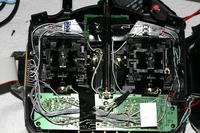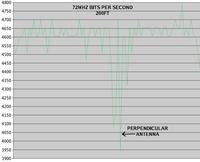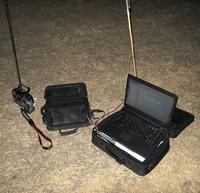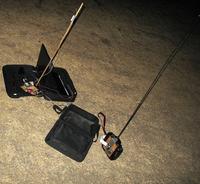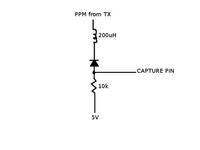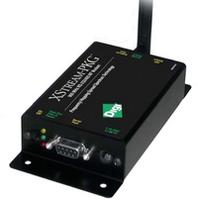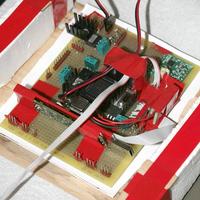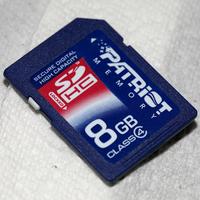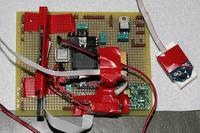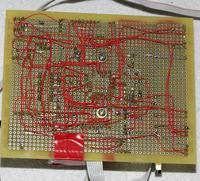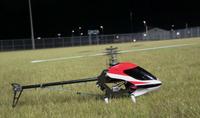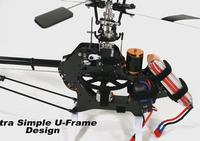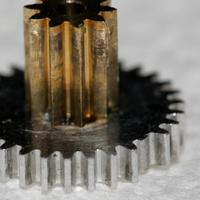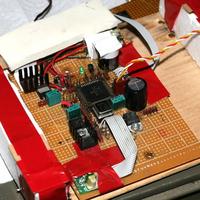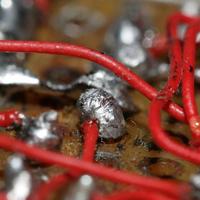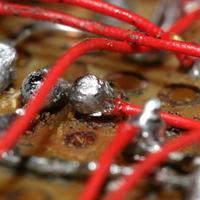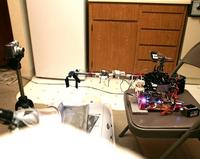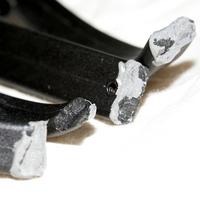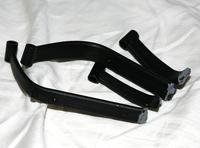Posted by Jack Crossfire |
Aug 30, 2008 @ 06:19 AM | 6,848 Views
So the answer is still no. U can't sample analog levels near a 72Mhz transmitter. The inductor method on Goog didn't work. The PPM wire was still tempermental. After a day of trying everything, ended up converting the PPM wire to an open drain inside the shielded part of the transmitter. There was only enough room in the shielded area for a transistor. It was a one component bullseye & the PPM became 72Mhz immune.
So use open drains with direct grounding & U don't need to worry about 72Mhz energy. Still no idea how precise the PPM is. It seems a bit noisy.
...Continue Reading
Posted by Jack Crossfire |
Aug 28, 2008 @ 12:52 PM | 6,789 Views
For the first time in years, actually found useful information on The Goog. Punching in "extracting buddy box ppm" is the sweet spot.
Mainly, U can capture analog levels near a 72Mhz transmitter. U need to isolate all the transmitter connections with RF chokes. The Goog recommends 100uH, so we're using 200uH. In an unshielded board, it's still tempermental even for PPM.
Posted by Jack Crossfire |
Aug 27, 2008 @ 05:45 PM | 6,799 Views
So in the RC rescue bill your government is putting together, conforming loans for aircraft are being offered to $415,000 with 0 down. Owers of expensive aircraft like copters & UAV's can borrow up to $750,000, as long as they prove they can't afford it.
We also have an $8000 first time pilot credit. $3.9 billion to buy & rehabilitate wrecks. $30 billion to help JP Morgan acquire Align. $25 billion to nationalize E-flight. Best of all, crashes R now FDIC insured up to $100,000. At least your taxes R funding something useful instead of worthless mcmansions.
Posted by Jack Crossfire |
Aug 27, 2008 @ 12:51 PM | 6,977 Views
Lets get one thing perfectly clear. If we had any money, this would be a stock 9 channel transmitter & stock 9 channel receiver, with 9 servo wires going into the ground station where they would be converted to autopilot functions & resent by a 2.4Ghz full duplex XBee. No soldering. No PPM decoding. That would be a truly untethered plug N play system.
Google searches for 9 channel radios R ugly. Ubama's RC stimulus bill looks better every day.
The binary to PPM modulation from last year works again & the link is sending binary from the transmitter directly to the laptop for the first time.
To use a 72Mhz transmitter, U can't capture any analog signals. Previously got good results by moving the antenna away from the transmitter, but analog readings drifted slightly & we now need very stable analog readings for autopilot commands. Decoding PPM is much easier, but not as accurate & fast as direct analog readings were.
Posted by Jack Crossfire |
Aug 25, 2008 @ 08:09 PM | 6,899 Views
The cost of 900Mhz came down again, but we decided to pass on it again & stick with another round of 2.4Ghz. U can wrestle a 900Mhz 115200bps Jesus modem out of Digi but it's going to stay a painful & expensive process until 2009. Interference between 900Mhz & GPS is a high risk, followed by unknown performance, followed by higher price. Already have run 2.4Ghz downlinks successfully & showed the 2.4Ghz can do 32000 bits/sec full duplex & 40ms latency.
In the mean time, the focus is advancing a 72Mhz link between transmitter & laptop.
Transmitter ---72 Mhz---> laptop <---2.4Ghz----> aircraft
Untethering the pilot in command is still a high priority, so there's no way to use 72Mhz as an uplink.
Practical ground based autopilot only seems to have appeared in the last year. Just 2 years ago, long range wireless modems were super expensive, heavy, & impractical compared to embedded computers. 802.11 cards were the gold standard & going over 300ft required an obscenely expensive brick that only did 19200bps.
Posted by Jack Crossfire |
Aug 24, 2008 @ 06:13 AM | 10,241 Views
No-one read the last blog post. How about this. It's "cloud" autopilot.
Remarkably, Google's entire XBee search database is advertisements or people trying to sell XBee's but no tests of its performance. Now for the first time, we have discovered the XBee sux at full duplex.
With the link saturated & no flow control, U get 88000 bits/sec in 1 direction. This seems to be the limit of the PIC.
Saturate in both directions & U get nothing even with the flow control.
The only way to get full duplex is to have 1 be the master & the other wait for a master packet, then send as much as possible & back off just before the next master packet is due. In this arrangement, the master packets need to be 20ms apart & U get 32000 bits/sec each way.
This isn't the 115200 bits/sec low latency we wanted & no-one wants to spend $70 on double XBees for every aircraft.
Well the XBee's got less & less reliable over time. The ground XBee occasionally stopped receiving while still transmitting successfully. Finally 1 or the other died.
Contrary to many social network hits & according to 1 of the many datasheets floating around, the $32 ones were not 5V tolerant. Only the new $36 ones are. Fortunately, a web page for a future $39 900Mhz XBee has appeared. This one has been upgraded to 115200 & the range downgraded to 1 mile. Probably not available until 2009.
Posted by Jack Crossfire |
Aug 23, 2008 @ 05:25 AM | 7,158 Views
Despite the getto measures, ground based autopilot would have some huge benefits.
VicaGlider would get a lot cheaper & easier. A lot of assembly language problems just vanish. A UAV fleet becomes possible by eliminating the embedded computer cost & the custom programming. Indeed, the first consumer UAVs from China R going to use extremely powerful ground based computers & the smallest possible bluetooth radios on the aircraft.
Got the PICs doing 115200 baud on the hardware UART. They only generate 17500 baud in telemetry. 100% of the bits have to make it. Have some range tests.
Definitely need a warning sound for when the bitrate drops below a certain amount, so the pilot can take over. Probably need someone pointing a directional antenna at it. Maybe a hand held laptop arrangement.
Posted by Jack Crossfire |
Aug 21, 2008 @ 06:21 PM | 7,570 Views
Before the first Gumstix, considered sending all the sensor data to the ground & doing all the control on the laptop. The idea seemed hopeless because the laptop didn't work, we didn't have fast radios, an embedded computer seemed like a 1 time purchase, but times have changed. Now the math.
A/D: 90 * (2 + 2 + 2 + 2 + 2 + 2 + 2)
Mag: 40 * (2 + 2 + 2)
GPS: 4 * (4 + 4 + 4 + 4 + 4 + 4 + 1)
Total down: 12800 bits/sec
The laptop would do all CCPM & send only PWM. The XBee sends 100 bytes at a time. Assuming it could work at the full 115200,
800/115200 + 800/115200 + some delay for the physical layer 1600/115200
28ms latency
You'd never reach that in wireless & there's a huge penalty for full duplex. The highest we ever got out of a PIC was 57600. Previously, the minimum delay for navigation was 50ms. All this would be done on the PIC.
Now what about doing control on the airframe & sending weights from the laptop. This would need a Netburner.
INS: 25 * (4 + 4 + 4)
GPS: 4 * (4 + 4 + 4 + 4 + 4 + 4)
Total down: 3168 bits/sec
Assuming 4 networks of 296 weights uploaded once a second, 50% compression, U need 80,000 bits/sec for the upstream.
Any laptop computation would unleash a massive amount of computing power for artificial intelligence. The barrier to entry would be much lower. The laptop would require new batteries eventually exceeding the cost of an airborne computer. It would require a lot of equipment. Things
...Continue Reading
Posted by Jack Crossfire |
Aug 21, 2008 @ 02:36 AM | 7,358 Views
Well, another few hours of reboots, flexing & playing, & the problem moved to 1 of the SDRAM chips. Looks like Gumstick #2 is dead. Also another PIC lost an analog pin.
Unfortunately, we're out of money for August. Now some options for September:
Draconian downgrade to a netburner or something & just get the job done with a software rewrite.
$100 Downgrade to the cheapest 200Mhz Gumstick & just get the job done with existing software.
$130 - $170 Replace with another 400Mhz to 600Mhz Gumstick & commit to a bigger neural computing campaign + a heavy case.
$195 Upgrade to a 500Mhz Blackfin & commit to a bigger neural computing campaign + a software rewrite.
All a main computer needs is 3 serial ports & not many clockcycles. The Blackfin has neither hardware floating point nor A/D, so it's a miss. The Netburner would need some hardware magic to make flight recordings & we all know what happened to the SD card campaign.
Nothing has happened with neural networks because it's unlikely such a small aircraft can get more stable. The way the pros do it is by developing a plant neural network & a controller neural network. The plant learns to predict results of control inputs & the controller uses the plant to train itself. They can't just flip the inputs & the outputs to make a controller out of a predictor.
We would have 2 networks for an attitude controller & 2 networks for a velocity controller. The networks themselves R black boxes, redesigned to suit the latest whim. The plant & controller are where the programming is & fixed components.
Posted by Jack Crossfire |
Aug 20, 2008 @ 03:13 AM | 6,750 Views
The Hirose connector is still killing us. Got it booting again with the Hirose in just the right angle. A Blackfin "camera board" appeared in the last year which can do PIC & Gumstick functions much faster. Either this guy is going to figure out he can make a lot more money calling it a computer or embedded computing is really a graveyard.
Posted by Jack Crossfire |
Aug 19, 2008 @ 03:31 AM | 7,000 Views
There it is. Board #2. Had a handful of errors & a few more reworks to fit in more heat sinks. The Gumstix isn't booting. Suspect power supply noise. Did another NASA & permanently soldered the radio to eliminate the connector from the next crash. These headers won't break off from vibration. Have a few more days of tests, calibration, cyclic training, & repairs. Time to forget about weight & spread the connectors out.
Posted by Jack Crossfire |
Aug 18, 2008 @ 12:47 AM | 6,948 Views
Despite all the communism, slavery, & steroids, ended up focusing more on the olympics this time. During the marathons, NBC snagged some aerial shots of Beijing which simply didn't exist before. Finally figured a way to get HDTV from the tuner which only works on an obsolete computer, to the computer fast enough to decode HD, to the 30" monitor. No DVR unfortunately.
China is going to be the world's largest economy again & the technology leader again. The only reason anyone else got ahead was petroleum, but those days R over.
Posted by Jack Crossfire |
Aug 16, 2008 @ 03:18 AM | 6,941 Views
U can't hire Moses unless U go all the way. Meet the dream team.
Ba ba ba ba ba ba ba ba Barrack + Tiga tiga tiga tiga tiga TigaWoods
Michael Phelps: secretary of steroids
Don King: secretary of defense
Hillary: attorney general
King Abdullah: secretary of energy
Jim Cramer: secretary of the treasury
It's going to be a fun 12 years.
Posted by Jack Crossfire |
Aug 15, 2008 @ 01:02 PM | 6,802 Views
Nowadays, U don't really need to know anything. Information becomes obsolete instantly. U can look up anything U need to know on demand, as long as it's the same thing everyone else is doing. Forget about looking up fake test pilot names.
Now today's sunset. Sat in traffic all through the best lighting. If only the day job had windows.
...Continue Reading
Posted by Jack Crossfire |
Aug 14, 2008 @ 01:13 AM | 7,086 Views
Reviewing the prices & terms of the online PCB fabricators pushed us pretty hard towards another proto board again. The proto board is $15 & can be built in a few days of hell. The PCB fabricators go from 3 weeks of waiting to $200, with tons of pain in between. U have to reinstall Windows to use expresspcb.com.
The proto board could be just as reliable as a PCB. The PCB would just be holes & traces for the same components we used before. The PCB would be lighter but require more structures to mount the breakout boards.
A PCB could need at least 2 revisions before it flew, so double the quote & turnaround time. The expensive ones would pay for a 900Mhz radio set.
900Mhz radio would be redundant to the 2.4Ghz radio when video downlink wasn't being used. That's a PCB revision already. Alternatively, there's programming some kind of auto landing. Unlike the pros, we don't have miles of flat terrain.
Posted by Jack Crossfire |
Aug 13, 2008 @ 04:23 AM | 7,227 Views
The extra range required to take advantage of non linear CCPM put the servos in a lot of stalled positions. It also pulled the washout base off the rods in the machine vision captures. Tried another round of manual CCPM.
Manual CCPM is flyable for a human. The human gets used to the collective crosstalk & nonlinearity. It's pretty bad for an autopilot. The autopilot using PID feedback can't handle the crosstalk & phase error. Maybe implementing proper phase would fix the cyclic.
Got through a number of tests before the next global killer. Adding noise to the PWM did not make cyclic more stable. The most stable results had no curve. The best explanation is the polled PWM changed duty cycles when the lines were high. The interrupt PWM updates once, as soon as the last line lowers, adding up to 40ms of delay.
Got all the way back to autonomous hover with the interrupt PWM & manual CCPM. She overcame the crosstalk & got it stabilized.
Well, the radio is still a problem. The syslog indeed captured a radio failure and a flight recording was captured with radio packets dropping out. Maybe it's time for auto landing if radio failure.
The crash during high altitude auto hover was a global killer. Nothing survived, not even bacteria. Probably time for a PCB.
...Continue Reading
Posted by Jack Crossfire |
Aug 12, 2008 @ 01:23 AM | 7,076 Views
The answer is yes. The Goog actually has a rudimentary kind of content search in GooTube. It isn't for helping you find videos. It's for enforcing copyrights. What did you think it was for?
Things they're probably searching for:
similar frequency patterns in the audio
fixed broadcaster logo
similar looking frames of video scaled to common sizes
They're not matching arbitrarily scaled video. Primative as it is, it's quite a leap from traditional Web 2.0 technology which is just 80's text searches with 30 gigabytes of sliding popup windows.
The Goog one needed copy protection protection.
The Vimeo one worked straight.
...Continue Reading
Posted by Jack Crossfire |
Aug 11, 2008 @ 01:55 AM | 6,787 Views
Only watched the opening ceremony. Behind all the noise about communism being great, the state guaranteeing everyone's future, the individual being worthless, how many LED's child laborers can solder, U realized if U gave any of those smiling performers a 1 way ticket out of China, they'd be out of there in 17 seconds.
Some of the visuals were faked, but most of them were probably real. If U focused on just the visuals, U realized how fast & far technology is moving & how it's heading in a common direction. Eventually there's going to be no correlation between form & function, placement & position of anything. Anything can be a display, a phone, or a building right now, but in the future anything can be anything.
Your government recently mandated Calif* houses to be worth $1 million. What is your government to do in a future where anything can be a house and a house can be anywhere? Workers will rent cardboard boxes for $100,000 a month but never know it. They'll plug into robots thousands of miles away which live in mansions & totally replace their sensory input with the robot's.
It's a tough future for a living thing to follow. We humans count on physical objects having definite functions & physical places having definite locations.
What to do when anything can do anything & anywhere can be anywhere? How do you retain any kind of achievement?
Speaking of technology, finally updated heroinewarrior.com with all our stuff linked from the mane page, a new version of Cinelerra which can do all the motion stabilization you've been seeing on the Jack Crossfire show.
Posted by Jack Crossfire |
Aug 09, 2008 @ 04:34 AM | 7,548 Views
Found the gyro bandwidth was doubled during the PWM rewrite, so set it back to its original value & got back to very similar gains as before the rewrite.
ANALOG_LOWPASS 1
Got all the way to the following gain:
CYCLIC_DAMPING 28
With this, if U push the stick over & snap it back she enters roll oscillation but recovers.
CYCLIC_DAMPING 32
is actually stable if she's not pushed. Snapping the stick over causes growing roll oscillation. So still evidence of noise adding slight stability.
Next, began adding nonlinearity to the feedback.
CYCLIC_DAMPING 24
CYCLIC_CURVE 128
Seemed to react the same. Unfortunately this was all we got before the aft cyclic servo failed again & she flung 30 ft across the ground. It may either be metal gears wearing out or gimbal lock with our crazy pushrod geometry. No-one is anxious to have a 3rd loss of control to find out.
Yaw damping seemed to oscillate the same whether 16 or 8. Need to try reducing yaw bandwidth.
Posted by Jack Crossfire |
Aug 08, 2008 @ 01:20 PM | 5,379 Views
So NASA originally proposed a small solid booster + a large upper stage. Upper managers got hired & said they knew better so they moved to a large solid booster & small upper stage.
5 years later, they've declared the new design unworkable. Leadership triumphs again.
It's how all businesses work. Workers have ideas, the project grows, leaders get brought in who know better & redesign, the redesign blows up.
So with the broken battery cover & battery wear, the A560 is down to 12 minutes of video per battery charge. It's worse than the DV camera when we decided the DV camera was useless.
Got 2 rate damping tests in between commutes & breakage. We can forget about linear damping over 16. The next commute is log damping. Another commute is fake noise.
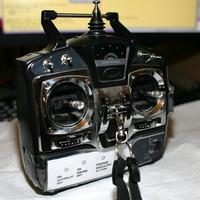 Views: 342
Views: 342 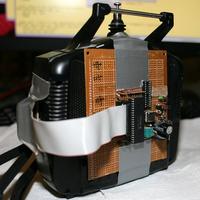 Views: 294
Views: 294 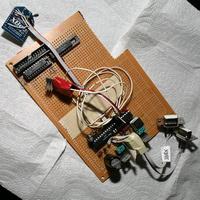 Views: 319
Views: 319 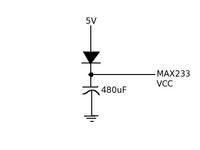 Views: 334
Views: 334  Views: 313
Views: 313  Views: 267
Views: 267 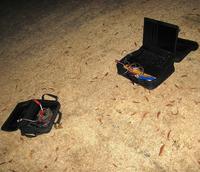 Views: 286
Views: 286 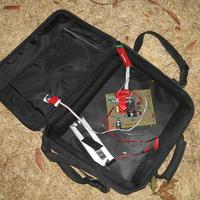 Views: 290
Views: 290 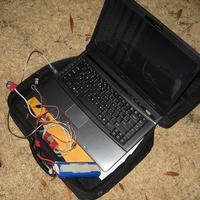 Views: 270
Views: 270 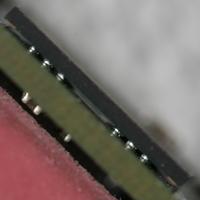 Views: 303
Views: 303 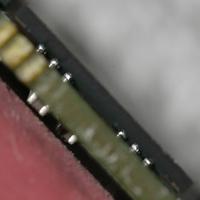 Views: 252
Views: 252  Views: 256
Views: 256  Views: 294
Views: 294 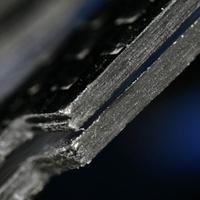 Views: 257
Views: 257 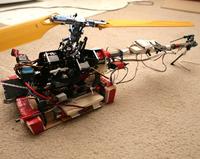 Views: 314
Views: 314 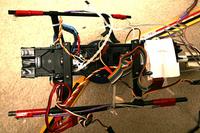 Views: 263
Views: 263 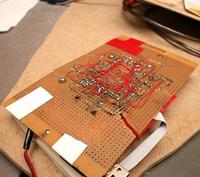 Views: 266
Views: 266  Views: 268
Views: 268 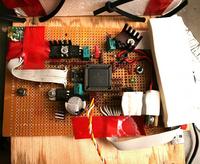 Views: 269
Views: 269 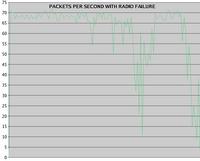 Views: 257
Views: 257  Views: 254
Views: 254  Views: 254
Views: 254  Views: 463
Views: 463  Views: 435
Views: 435  Views: 464
Views: 464  Views: 1013
Views: 1013  Views: 432
Views: 432 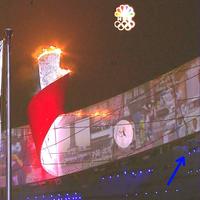 Views: 526
Views: 526 